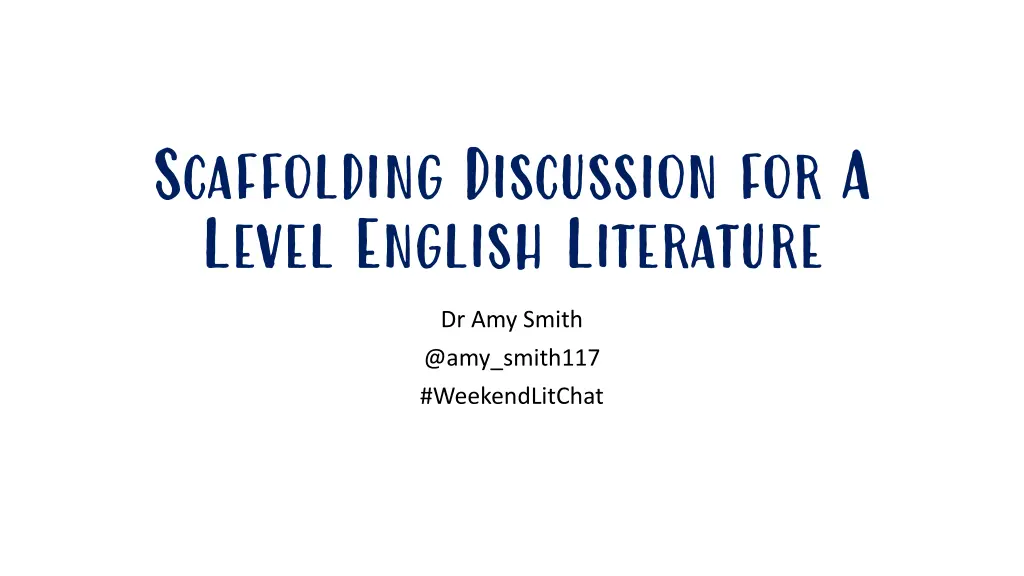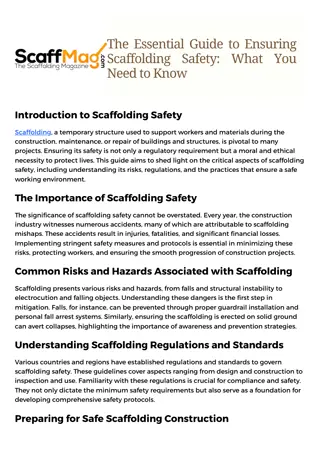
Fostering Engaging Literature Discussions
Empower your students through constructive discussion in A Level English Literature. Learn the importance and strategies for creating a psychologically safe environment, building student confidence, and enhancing subject knowledge. Prepare effectively for meaningful discussions in your classroom.
Download Presentation

Please find below an Image/Link to download the presentation.
The content on the website is provided AS IS for your information and personal use only. It may not be sold, licensed, or shared on other websites without obtaining consent from the author. If you encounter any issues during the download, it is possible that the publisher has removed the file from their server.
You are allowed to download the files provided on this website for personal or commercial use, subject to the condition that they are used lawfully. All files are the property of their respective owners.
The content on the website is provided AS IS for your information and personal use only. It may not be sold, licensed, or shared on other websites without obtaining consent from the author.
E N D
Presentation Transcript
Scaffolding Discussion for A Level English Literature Dr Amy Smith @amy_smith117 #WeekendLitChat
What would I tell my 2005 self? Discussion is important because it helps the teacher to oDevelop ideas by bringing a wider range of possibilities to the table to expand understanding; oCheck students understanding; oGive students an opportunity to practice articulating their ideas reading and writing float on a sea of talk (James Britton); oPreparation for university interviews and seminars: cultural capital.
Creating the conditions for discussion An environment is psychologically safe when people feel they can offer suggestions and take sensible risks without provoking retaliation or ridicule. (Mary Myatt Back on Track)
Creating the conditions for discussion Make it easy for them to participate in discussion and hard for them not to. (Tom Bennett Running the Room)
Creating the conditions for discussion oEnsure excellent subject knowledge oClearly communicate high expectations oDevelop a sense of trust and belonging
Creating the conditions for discussion Preparation: your subject knowledge oCareful pre-reading and annotation of your copy of the text is key; oTake opportunities for online CPD (MASSOLIT/ twitter/ LitDrive); oFind opportunities for pre-discussion within your department or online (for example, send me a question for #WeekendLitChat).
Creating the conditions for discussion Preparation: the students subject knowledge oStudents will feel more confident engaging in discussion if their knowledge base is secure. oKnowledge organisers distil the core knowledge prior to teaching; oRegular, predictable, spaced knowledge retrieval; oIf possible, look at GCSE work or speak to their GCSE teachers; oRegular checking of students understanding; oEffective homework setting (e.g. Cornell note-taking for MASSOLIT/youtube lectures; pre-reading; consolidation tasks; MCQs).
Creating the conditions for discussion Clearly communicate high expectations
Creating the conditions for discussion Develop trust and belonging oValue all voices equally and listen carefully; oMake discussion low stakes regular and with predictable expectations; o3 point discussion (as recommended for instructional coaching in WalkThrus); oScaffold high expectations.
The discussion itself Questioning strategies oBalance of cold-calling and students indicating they wish to enter the discussion (e.g. hand up). oABC questioning: oAgree do you agree/disagree with X s idea? Why? Where is your evidence for that? Does that link to Y s thoughts about ? oBuild what can you add to Z s thinking there? What evidence might Z be able to use to support their argument? What might Z have forgotten? Could Z link this idea to another character in the text? oChallenge what about the counter-argument that ? Have you considered ? How do X s ideas counter what you are saying? oPre-release questions. oShow genuine curiosity there doesn t have to be a pre-determined destination or answer.
The discussion itself Think Pair Share Your ideas Your partner s ideas The class s ideas
The discussion itself Think Pair Share And/or o Word bank o Quotations list
The discussion itself Think Pair Share oWhat did you and your partner discuss? oA low stakes question the student does not have to aim for a correct answer. oLeaves the discussion open for divergent ideas. oGive me one sentence to summarise your discussion with your partner. oLow stakes, limited, clear expectations. oCredit to Stacey Reay.
The discussion itself Rehearsal and repetition say it again better oHow could you include this word in your response?; oSam, can you summarise Siobhan s argument for us?; oGood ideas and they were a bit fragmented. Can you put it together in 2 sentences?; oThat s a really important concept to be able to explain everyone, take 60 seconds to explain X to your partner. [Then randomly sample the class and repeat until they are all fluent.]
The discussion itself Coping with mistakes oNormalise mistakes we all make them and they are an opportunity for learning; oModel how to approach a lack of knowledge or understanding [I m not sure what Coleridge said about Iago I m just going to check my notes ]; oGive time to refer to knowledge organisers / notes; oQuick think pair share; oStrip it back to concrete knowledge and bring the whole class in then build up incrementally [Ok, let s take a step back Zeyna. Lewis can you remind us what Othello says to Desdemona when he arrives at Cyprus? And what does that mean Ben? So what can we learn about their relationship at this point in the play Lydia?].






















